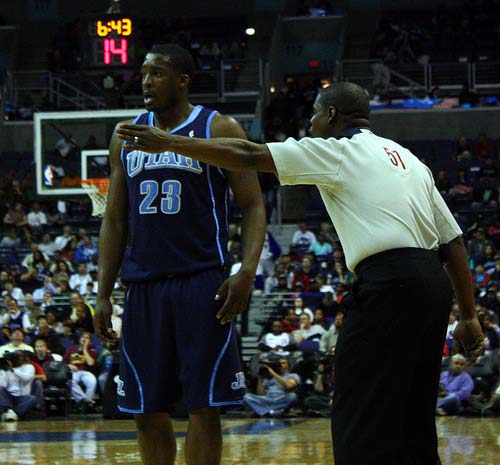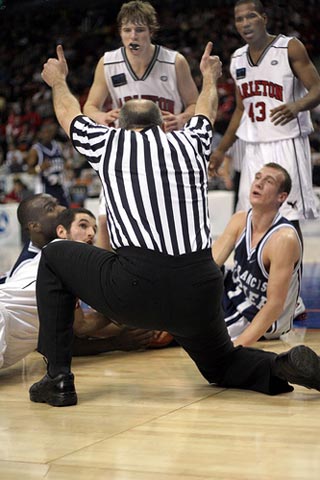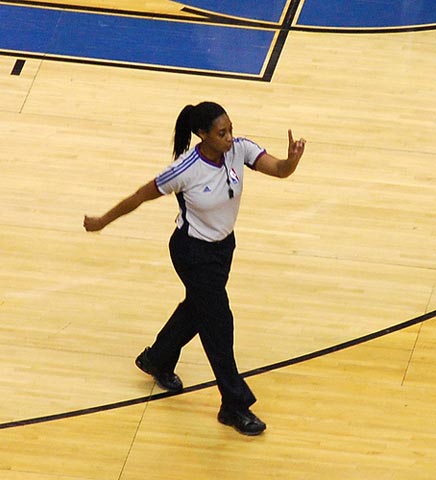Basketball Referee Hand Signals
Have you watched a basketball game lately? Even if you are used to following the action, it can often be difficult to understand all of the referees' hand signals during the game. Like many of you, I was a bit puzzled by some of these signals-even common ones-for a long time. Since I got tired of waiting for announcers to explain it, I decided to look up all the different hand signals and their exact meaning. Plus, for the benefit of all my fellow Best Sports Blog community members, I decided to break down the most important Basketball Referee Hand Signals so you are never confused again. So, here goes:
Three Second Rule: An arm and three fingers are raised but kept close together. The rule means that a player has stayed in one place defensively for longer than three seconds and it is considered a minor penalty.
Twenty Second Timeout: Both arms raised and folded to touch the inner shoulders near the neck indicates that one team has taken a twenty second time out and halted game-play.
Charging: The right arm is extended outward to create a 'half T' motion with the body indicates charging, which is when an offensive player collides into a set defender and commits a personal offensive foul.
Looking for a LeBron James Jersey!
Thanks to truthaboutit from Flickr.com for this great picture of Referee Correcting Rookie.
Holding: The referee uses one hand to hold his other wrist to indicate that a player-usually a defender-has held an opposing player.
Illegal Screen: When the referee crosses his arms across his upper chest, the movement indicates an illegal screen or 'pick' by an offensive player.
Jump Ball: When the referee raises both arms and makes a "thumbs up" motion with both hands, this indicates that both team managed to maintain possession and a jump ball is needed.
Visit Kevin Durant Jersey
Thanks to Michael Rajzman from Flickr.com for this great picture of Jump Ball.
Personal Foul: The referee raises one arm and forms a fist to indicate a personal foul.
Technical Foul: When the referee forms a “T” motion with his arms and hands, this indicates that a player has been called for a technical foul. Technical fouls typically come from instances of bad sportsmanship or arguing with officials.
Shopping for a Michael Jordan Jersey
Thanks to Adam Fagen from Flickr.com for this great picture of NBA Referee.
Travelling: The referee uses his arms and hands to make a circling motion in front of his chest to indicate that a player has travelled with the ball and turned it over.
There are, of course, many other signals but these are those that are most commonly used. If there are some important ones neglected here, please comment or leave that information below for the benefit of the whole Best Sports Blog community.
What do you think?
We'd love to hear your comments and/or opinions. If you submit them here, other visitors can read them, rate them and comment on them. An e-mail address is not required.
From Basketball Referee Hand Signals to NBA Basketball Blog | Sports Blog | NFL Football Blog | NCAA Football Blog | NFL Football Archives | College Football Archives | Current Sports Scores | NCAA Basketball Blog | NBA Basketball Archives | NCAA Basketball Archives | Current Sports Scores | MLB Baseball Blog | College Baseball Blog | MLB Baseball Archives | Fantasy Football | Fantasy Basketball | Fantasy Baseball | The Best Sportswriter Contest | Sports Trivia Questions | Other Sports | Soccer Archives | Olympics Archives | Stupid Athletes Archives | Other Archives | Sports Basics | Top Sports Blogs | Best Sports Pictures | The Best Sports Videos | Best Current Sports News | The Best Sports Blog Podcasts | Football Forum | Basketball Forum | Baseball Forum | NFL Football Store | NBA Basketball Store | MLB Baseball Store | NCAA Football Store | NCAA Basketball Store | NCAA Baseball Store | Fatheads | NFL Football Tickets | NBA Basketball Tickets | MLB Baseball Tickets | NCAA Football Tickets | NCAA Basketball Tickets | NCAA Baseball Tickets | Best Sports Blog Books |
About Us | Contact Us | Site Search | Advertise | Terms of Use |









New! Facebook Comments
Leave a comment about this article in the box below and share it with your Facebook friends.